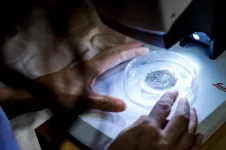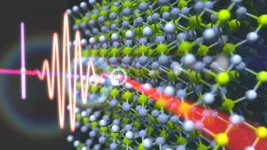(Press-News.org) CORVALLIS, Ore. - Statistical modeling developed by Oregon State University researchers has confirmed that changes to melanoma patients' gut microbiome led them to respond to a type of treatment capable of providing long-term benefit.
Findings were published in Science.
The modeling technique invented by Andrey Morgun of the OSU College of Pharmacy and Natalia Shulzenko of Oregon State's Carlson College of Veterinary Medicine is known as transkingdom network analysis.
The human gut microbiome is a community of more than 10 trillion microbial cells from about 1,000 different bacterial species, and transkingdom network analysis integrates multiple types of "omics" data - metagenomic, metabolomic, lipidomic, proteomic, etc. - in determining how interactions among specific types of gut microbes help or hinder biological functions in the host.
In this case, the microbial interactions involved how well the body responds to a type of cancer treatment known as anti-programmed cell death protein therapy, abbreviated to anti-PD-1 therapy. It allows immune cells to react more strongly to cancer.
"It was pretty dramatic," said Morgan, associate professor of pharmaceutical sciences. "We found altering the gut microbiome can take a patient with advanced melanoma who has never responded to immunotherapy, which fails about 60% of the time with this kind of cancer, and convert the patient into one who responds to it."
Morgun and former OSU postdoctoral researcher Richard Rodrigues, now at the National Cancer Institute, were part of a collaboration led by immunologists Giorgio Trinchieri and Amiran Dzutsev from NCI and medical oncologists Hassane Zarour and Diwakar Davar of the University of Pittsburgh that tested fecal microbiota transplants' ability to help melanoma patients benefit from anti-PD-1 immunotherapy.
The scientists collected fecal samples from patients who responded particularly well to the therapy and in a clinical trial gave the samples, via colonoscopy, to advanced melanoma patients who had never before responded to immunotherapy.
The patients then received the anti-PD-1 drug pembrolizumab, and this time it had the desired effect, turning non-responders into responders. Transkingdom network analyses confirmed the microbiome's role.
"Putting everything together, we showed that the fecal microbiota transplants and anti-PD-1 drug can change the gut microbiome and effectively reprogram a tumor's microenvironment so anti-PD-1 resistance is overcome," Morgun said.
Of 15 patients with advanced melanoma - an aggressive form of skin cancer - who received the combined treatment, six of them showed either tumor reduction or disease stabilization that lasted for more than a year.
"The promising findings clearly warrant more investigation in bigger clinical trials," Morgun said. "That way we can better identify microbial, bloodstream and intratumor biomarkers to select melanoma patients most likely to benefit from microbiome-based therapy. We really expect that eventually we'll identify a collection of bacteria with a high success percentage for converting immunotherapy non-responders into responders."
INFORMATION:
Merck and the National Institute of Health supported this research.
Water is a necessity for all life but its availability can be limited. In geographical areas experiencing dry seasons, animals congregate near the few freshwater sources, often reaching large densities. At these sites many animals from different species come to the same spots to drink, potentially operating as key locations for pathogen transmission within and between species. An international team of scientists lead by the German Leibniz Institute for Zoo and Wildlife Research (Leibniz-IZW) suggests that viruses can use restricted freshwater sources as a vector to be spread among animals. The key prediction of this idea is that animal viruses remain stable and infectious in water. The team ...
The effects of microplastics on our health and the environment are being rigorously studied all across the world. Researchers are identifying microplastic sources and their potential routes to the environment by examining rainwater, wastewater, and soil.
Microplastics have been found in nearly all organisms and habitats everywhere in the world. However, factors contributing to the influx and accumulation of microplastics in water ecosystems aren't fully understood yet. The focus of microplastics research has, for a long time, been on the age of microplastics found in sediments, and on the ...
The researchers analysed cells, mouse models, and human patient samples using biochemical, mathematical, and biophysical methods. They identified a protein present in the mesh-like membrane structure (the basement membrane) associated with tumour and vessel softness, and good survival of cancer patients. The researchers tested if removing this protein from the basement membrane would enhance the spread of cancer, which it did, and if supply of this protein would reduce cancer spread, which it did. They proceeded to show that the levels of this protein (netrin-4) already present in basement membrane of organs may determine cancer spread even before cancer develops, ...
Cells of organisms are organized in subcellular compartments that consist of many individual molecules. How these single proteins are organized on the molecular level remains unclear, because suitable analytical methods are still missing. Researchers at the University of Münster together with colleagues from the Max Planck Institute of Biochemistry (Munich, Germany) have established a new technique that enables quantifying molecular densities and nanoscale organizations of individual proteins inside cells. The first application of this approach reveals a complex of three adhesion proteins that appears to be crucial for the ability of cells to adhere to the surrounding tissue. The research results have been published in the journal Nature ...
Using an advanced technique, scientists from the RIKEN Cluster for Pioneering Research have demonstrated that a chemical reaction powered by light takes place ten thousand times faster at the air-water interface--what we usually call the water surface--than in the bulk of the water, even when the light has equivalent energy. This finding could help our understanding of the many important chemical and biological processes that take place at the water surface.
Water is the most important liquid in nature, and research has shown that there is in fact something special about the interface. For reasons that were not well understood, it appears that some chemical reactions take place readily when the molecules are partly in the water, but not when they are fully ...
The risk of both mortality and rehospitalisation after an elective revascularisation procedure for coronary artery disease is similar for people with and without Alzheimer's disease (AD), but people with AD had worse outcomes after an emergency procedure, according to a new study from the University of Eastern Finland.
Previous studies have investigated the effectiveness of revascularisation in persons with cognitive disorders, but only in terms of short-term outcomes and in acute care settings, and they also have not accounted for electivity. Similar to previous ...
New analysis published in The Lancet Psychiatry has shown a lack of strong evidence to support current guidance on psychological therapies for treating anorexia nervosa over expert treatment as usual.
The findings highlight a need for further research and support a call for individual trial data to be made available so the benefits of treatments in specific patient populations can be better understood.
Conducted by an international team of clinical experts and researchers, the analysis included 13 randomised controlled trials and a total of 1049 patients. The studies compared psychological therapies to treatment as usual in adults receiving outpatient treatment for anorexia. The trials measured eating disorder ...
Drilling a 270,000-year old core from a Tasmanian lake has provided the first Australian record of a major global event where the Earth's magnetic field 'switched '- and the opportunity to establish a precedent for developing new paleomagnetic dating tools for Australian archaeology and paleosciences.
"This is the first study of this kind in Australia since pioneering studies in the 1980s," said author Dr Agathe Lisé-Provonost, a McKenzie Fellow from the School of Earth Sciences at the University of Melbourne.
"Just two lakes in north-east Australia previously provided such "full-vector" record, where both the past directions and the past intensity of the Earth magnetic field are obtained from the same cores."
Published in the journal Quaternary Geochronology, Chronostratigraphy ...
Milan, 15 February 2021 - Excitons are quasiparticles which can transport energy through solid substances. This makes them important for the development of future materials and devices - but more research is needed to understand their fundamental behaviour and how to manipulate it. Researchers at Politecnico di Milano in collaboration with the Institute of Photonics and Nanotechnologies IFN-CNR and a theory group from the Tsukuba University (Japan) and the Max Plank Institute for the Structure and Dynamics of matter (Hamburg, Germany), have discovered that an exciton can simultaneously adopt two radically different characters when it isstimulated ...
The researchers of TPU together with their colleagues from Russian and foreign scientific centers have found a way to estimate the temperature of a chemical reaction activated by pseudo-particles - plasmons. Two organic molecules served as ultra-small sensors or thermometers. According to scientists, the experiments are of great fundamental importance: beyond the mere fact of evaluating the temperature with the use of molecules, it was possible to demonstrate that properties of plasmon serving as an activator of chemical reactions depend not only on thermal ...





